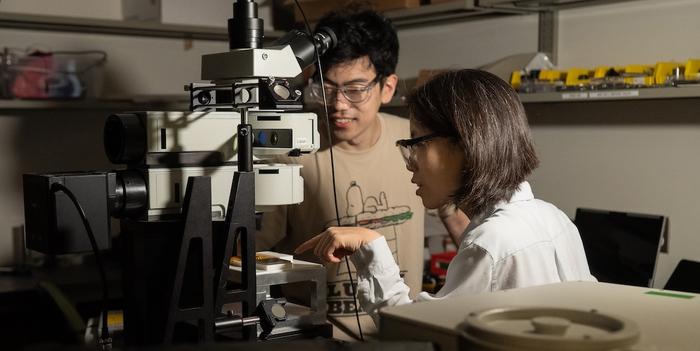
In a groundbreaking advancement at Rice University, researchers have unveiled a pioneering machine learning algorithm designed to revolutionize the interpretation of optical spectroscopy data. This new technology, termed Peak-Sensitive Elastic-net Logistic Regression (PSE-LR), promises unprecedented precision in analyzing the subtle and complex “light signatures” emitted by molecules, materials, and biological samples. The implications for medical diagnostics and material sciences are profound, potentially accelerating early disease detection and fostering the development of smarter, more sensitive biosensors and diagnostic devices.
Optical spectroscopy—an analytical technique based on how light interacts with matter—has long been a staple in scientific research, providing unique spectral fingerprints for molecules and tissues. Yet, despite its power, the interpretation of spectral data remains a significant bottleneck, largely due to the intricate and overlapping signals typical of biological and chemical samples. Traditional computational techniques often struggle to discern subtle spectral differences or lack transparency in their decision-making processes, limiting their utility in critical real-world applications.
Addressing these challenges, the team led by doctoral student Ziyang Wang and associate professor Shengxi Huang has engineered PSE-LR, an advanced yet interpretable machine learning model tailor-made for optical spectroscopy. This model excels at recognizing minute peaks within spectral data, honing in on the most crucial features that indicate biological or material states. By focusing specifically on these spectral peaks, PSE-LR not only delivers high classification accuracy but also produces a “feature importance map,” revealing which parts of the spectrum influenced its decisions. This transparency is vital when verifying results in clinical or scientific contexts, where understanding the basis of an algorithm’s conclusion is as important as the conclusion itself.
The significance of PSE-LR lies not only in its analytical prowess but also in its interpretability. Many contemporary machine learning models act as “black boxes,” making it difficult for researchers to extract meaningful insights or validate results independently. By contrast, PSE-LR acts much like a skilled detective—meticulously uncovering key signatures in light-scattered signals and presenting these clues in a user-friendly format. This paradigm shift might transform how optical spectra are analyzed, offering a powerful tool that bridges cutting-edge computational analysis with scientific transparency.
Extensive testing has demonstrated PSE-LR’s superiority over existing algorithms, particularly in scenarios involving subtle or overlapping spectral features that typically challenge conventional models. This heightened sensitivity enables applications ranging from detecting ultralow concentrations of viral proteins—such as the SARS-CoV-2 spike protein in bodily fluids—to identifying neuroprotective agents in mouse brain tissue. The model has also shown remarkable capability in discriminating pathologies associated with Alzheimer’s disease and in differentiating between complex nanomaterials like two-dimensional semiconductors.
Beyond medical applications, PSE-LR’s versatility could redefine materials science, where understanding nuanced light-matter interactions is crucial for the design of next-generation sensors and nanoengineered devices. By categorizing intricate spectral data with greater clarity, researchers can explore new frontiers in both diagnostics and material characterization, potentially leading to smarter, faster, and smaller analytical instruments.
The development of PSE-LR emerges at a pivotal moment when the scientific community is increasingly leaning on artificial intelligence to parse vast datasets. Yet, the crucial balance between model complexity and interpretability has remained elusive. This new approach paves the way for machine learning models that are as insightful as they are intelligent, enabling practitioners to trust and act upon their findings with confidence.
Another notable aspect of this research is its foundation on robust experimental studies involving animal tissue samples—a critical step toward translational applications in health care. Through rigorous validation, PSE-LR has proven its capacity to detect subtle biomolecular variations embedded within complex biological tissues, underscoring its potential to serve as a frontline technology in medical diagnostics.
This innovation is backed by major funding bodies including the National Science Foundation, the National Institutes of Health, and the Welch Foundation, highlighting the project’s scientific merit and societal relevance. The Rice University team’s commitment to open scientific progress ensures that PSE-LR’s capabilities can be rapidly integrated and refined across different research and clinical settings.
In summary, PSE-LR represents a milestone in the intersection of optical spectroscopy and machine learning, delivering a sophisticated analytical tool capable of extracting and elucidating vital information from challenging spectral data. Its ability to reveal underlying biological and material processes with precision and clarity holds promise for significant advances in healthcare diagnostics, material innovation, and beyond.
Looking ahead, the research community anticipates that the incorporation of PSE-LR into broader diagnostic frameworks will accelerate the translation of optical spectroscopy findings into practical, real-world health solutions. The promise of early, non-invasive detection of diseases such as Alzheimer’s, combined with improved material analysis, charts a transformative path for science and technology.
By transforming complex spectral signals into actionable intelligence, Rice University’s new machine learning approach may well herald a future where the physics of light and the power of artificial intelligence converge seamlessly, advancing our ability to diagnose, understand, and innovate across multiple scientific domains.
Subject of Research: Animal tissue samples
Article Title: Machine Learning Interpretation of Optical Spectroscopy Using Peak-Sensitive Logistic Regression
News Publication Date: April 28, 2025
Web References:
https://pubs.acs.org/doi/10.1021/acsnano.4c16037
https://news.rice.edu/
https://profiles.rice.edu/faculty/shengxi-huang
References:
Wang, Ziyang, et al. “Machine Learning Interpretation of Optical Spectroscopy Using Peak-Sensitive Logistic Regression.” ACS Nano, 15 Apr. 2025, DOI: 10.1021/acsnano.4c16037.
Image Credits: Photo by Jeff Fitlow/Rice University
Keywords: Machine learning, Tissue samples, Light matter interactions, Medical tests, Computer modeling, Light signaling, Laser light, Public health, Academic researchers, Spectroscopy
Tags: advanced data interpretation techniquesbiosensor technology developmentclarity in light-based data analysisenhancing disease detection methodsinnovative machine learning algorithmsinterpreting molecular light signaturesmachine learning for optical spectroscopymedical diagnostics advancementsoptical spectroscopy applications in sciencePeak-Sensitive Elastic-net Logistic RegressionRice University research breakthroughsspectral data analysis challenges





